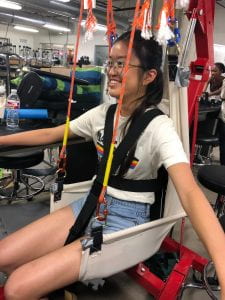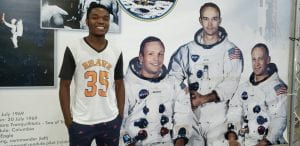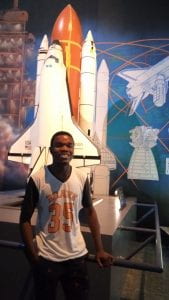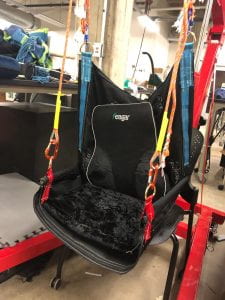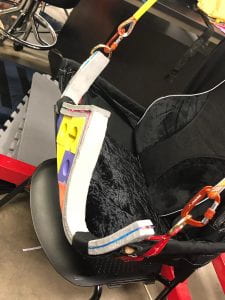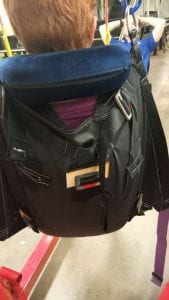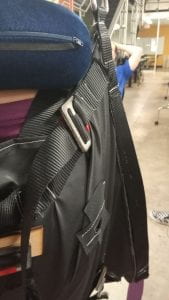Hello everyone,
It’s the sixth week of SEED and things have been intense so far as we are trying to come up with the final designs of our projects and perform different tests to assess the intended functions of these projects.
Last week Friday, we finished two prototypes. One had a slightly wider seat compared to the back support. We made the back support smaller because we noticed in the previous designs, there was extra fabric just hanging at the back even after tighten the straps. We identified this as a weakness because harness devices are supposed to have a tight fit, such that only two fingers should fit between the device and the skin.
Audrey testing the prototype with the smaller back support
This prototype worked better with smaller bodies but could not fit bigger bodies. We noticed this after Andrew, my teammate, sat in the device. His back was barely supported. We also tried to have adulfo, our TA, sit in it but it tore off.
During the weekend, the office of international students bought tickets for us to visit the NASA space center which was very interesting.
Monday, July 15
In the morning, we reflected on the observations we made on Friday and decided to increase the width of the back support to the original size. We also used a double layer of muslin and canvas to make the seat support.Another change was the use of strap in the sides of the back support instead of the wooden rods. This is the prototype that proved to be the most successful in terms of the amount of weight supported. It managed to hold a adulfo while carrying a 50 lbs weight on his lap without tearing. This was a huge step forward for the team. Although this prototype was a success, it had its weaknesses. Some of the weaknesses were it was small so users could not sit comfortably, legs were being squeezed together and the straps needed improvements.
Tuesday, July 16
After the morning meeting, we decided to make one more medium fidelity prototype. We made the final presentation of our sewing patterns and dimensions. We increased the lengths of both the back and seat, making each 22 inches from 18 inches. We also decided to use Canvas to make this prototype. This type of canvas is water resistant and has a UV resistance of up to 500 hours. We used the previous teams belts to strap the user into the device. After completing this prototype, we were confident to go forward and start working on the high fidelity prototype since we had all the details and dimensions mapped out. Later in the day, we started working on our testing plans for the device.
The final medium prototype on display
Wednesday, July 17
In the morning meeting, we got a lot of feedback on how we can improve our testing plans and make them more detailed. Right after the morning meeting we worked on that. We had Grant and Adulfo help us through the whole process. In the afternoon, we tested the medium fidelity prototype for comfort and support and range of motion. We also sent emails to different summer camps taking place at rice to bring kids to the oedk so that they can try out our device. This because our device is designed for kids so its on right we have kids test it out.
Thursday, July 18
We decided to make the high fidelity prototype. It was pretty similar to the final medium prototype. It is made if canvas. A double layer of canvas is added on the seat for more support. It has two shoulder straps that resemble that of a back pack and another strap that comes up on the upper abdomen.
We had chance of testing it two kids and we plan to do more testing tomorrow. Majority of the kids will come to the oedk tomorrow.
Dr hunter testing out the high fidelity prototype
